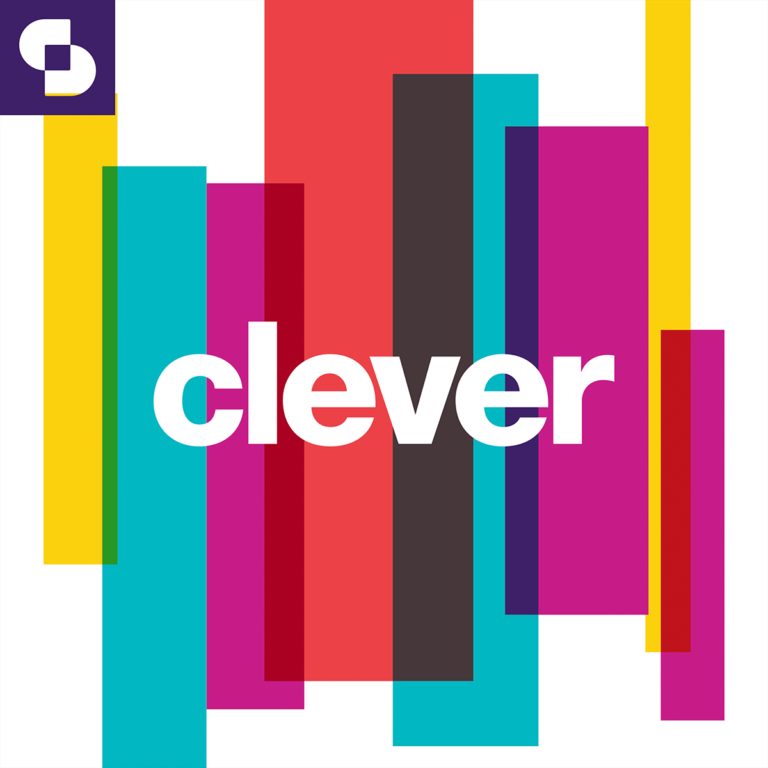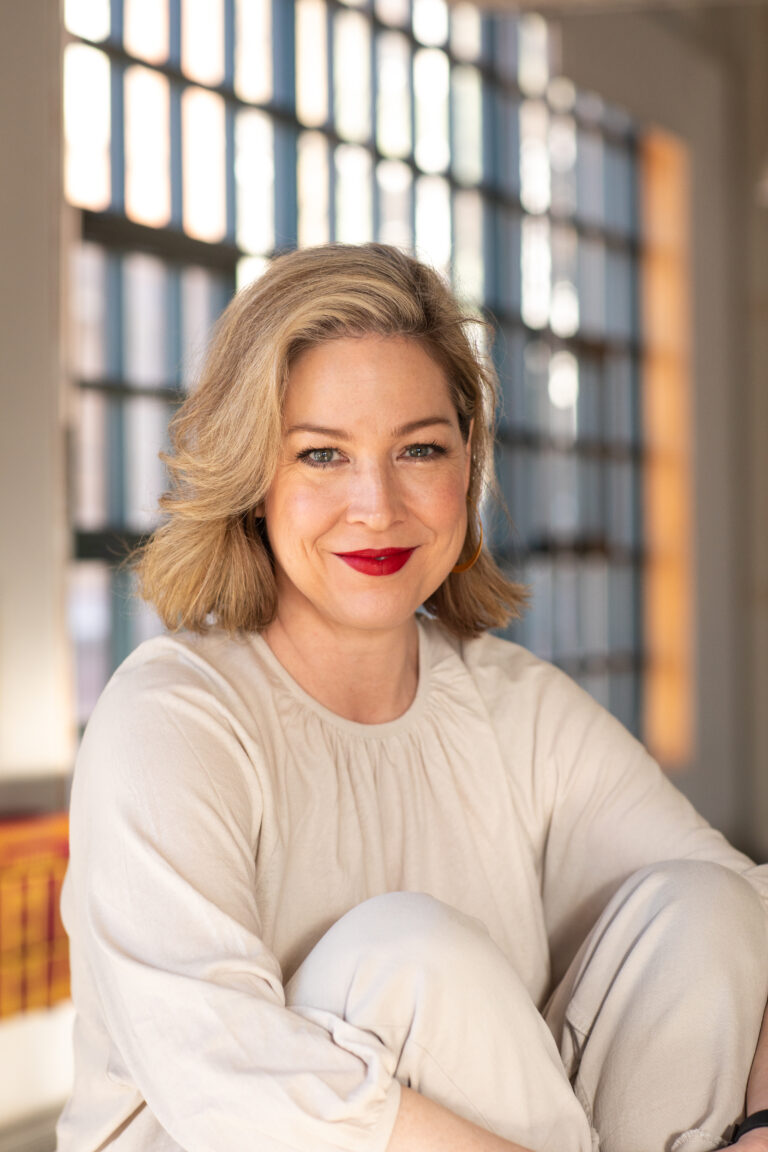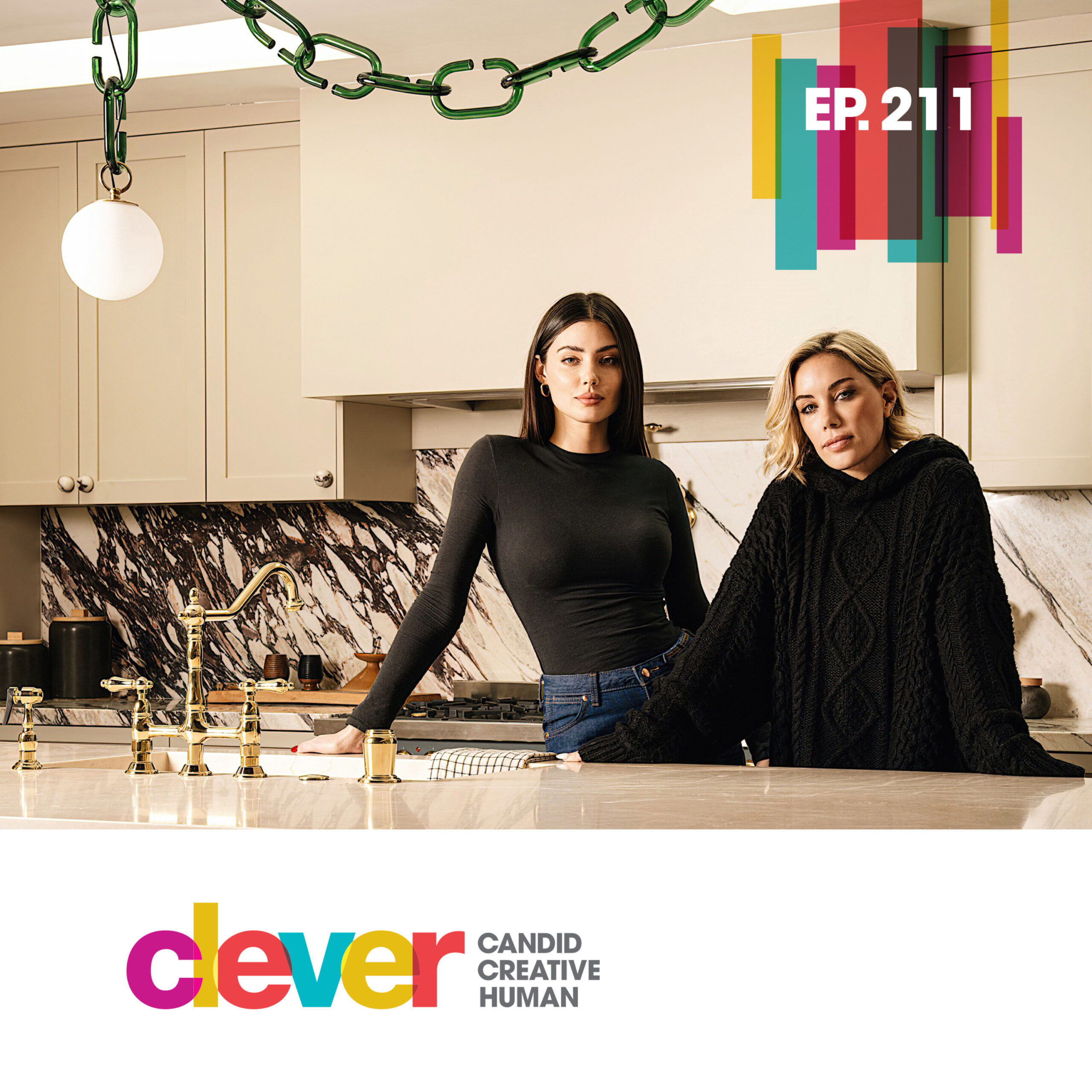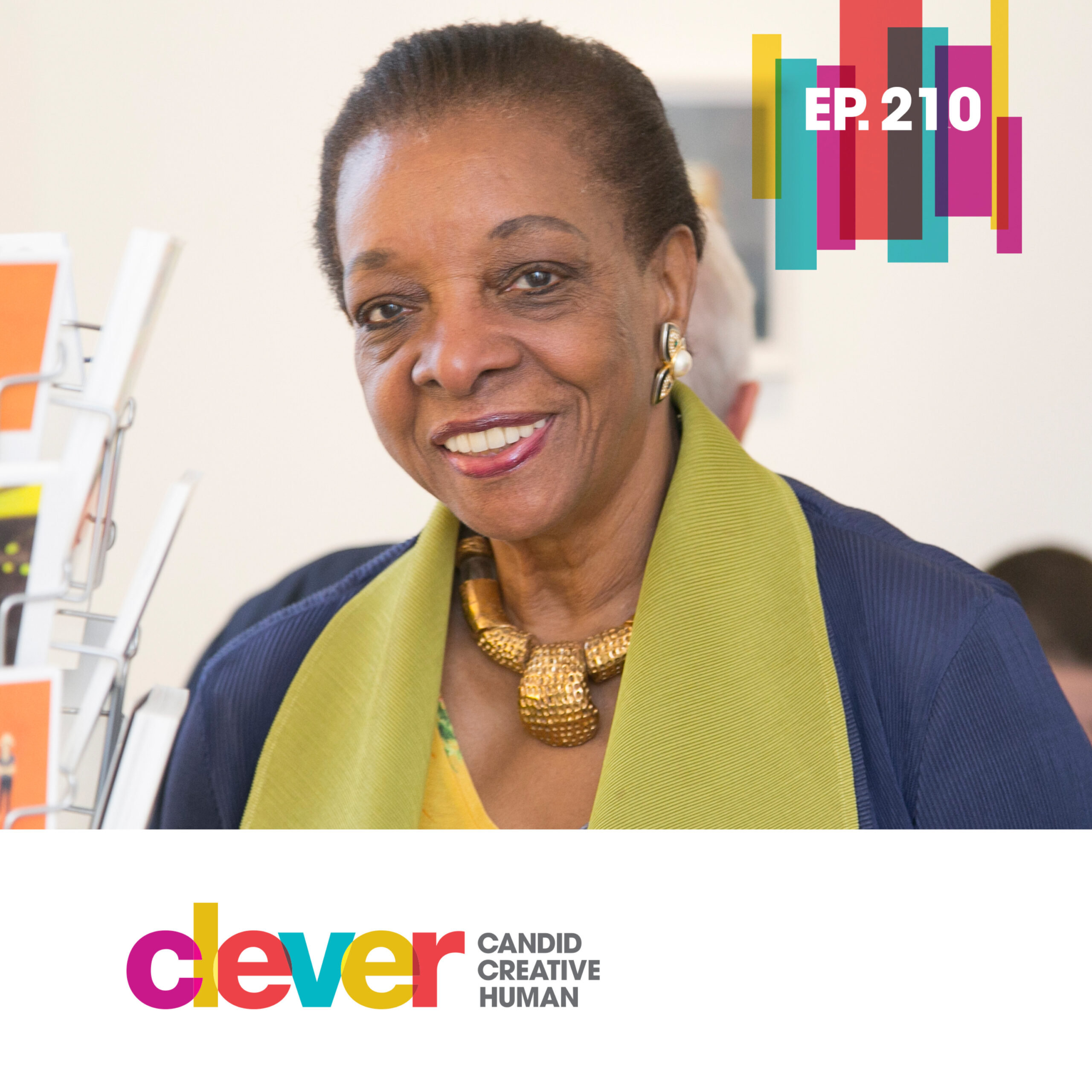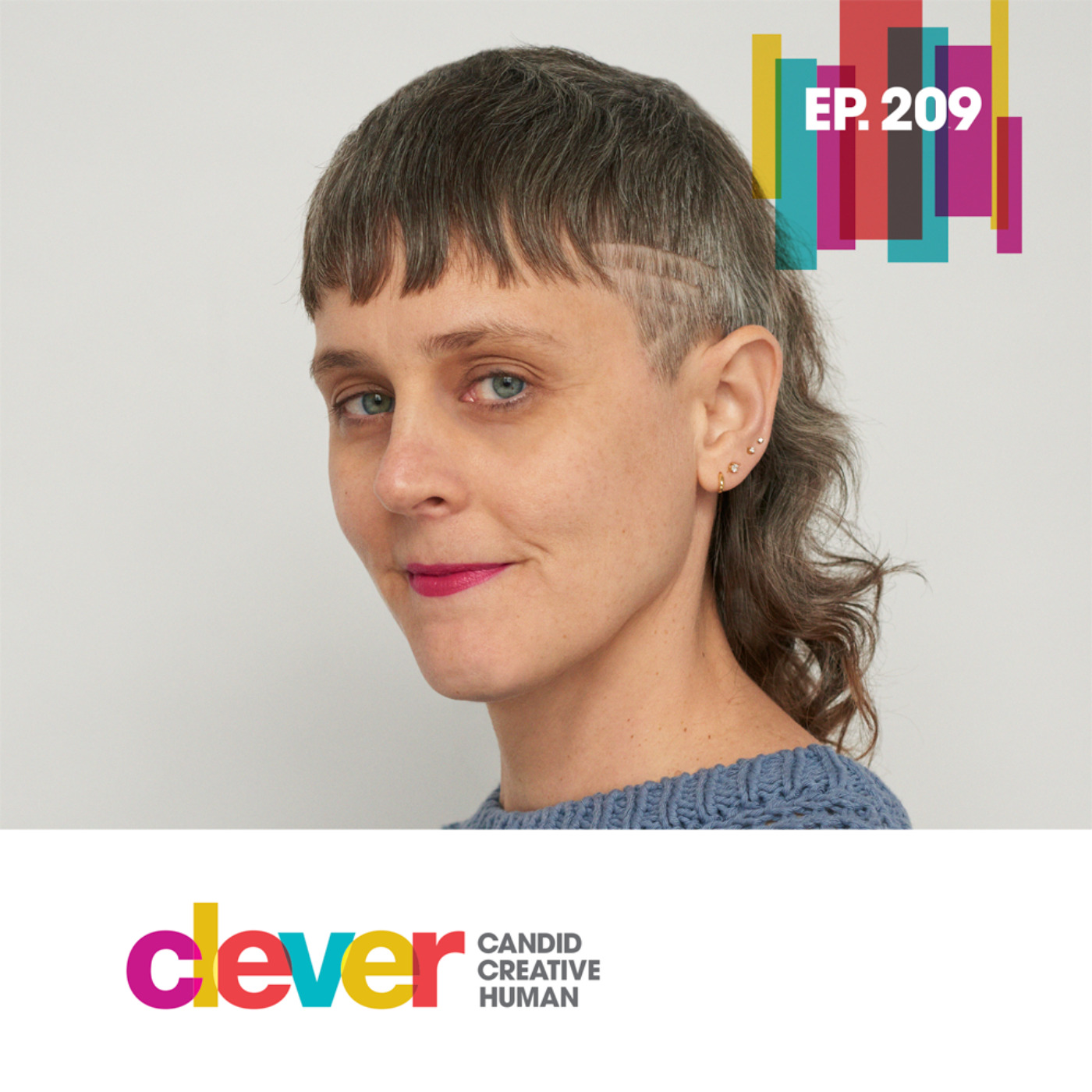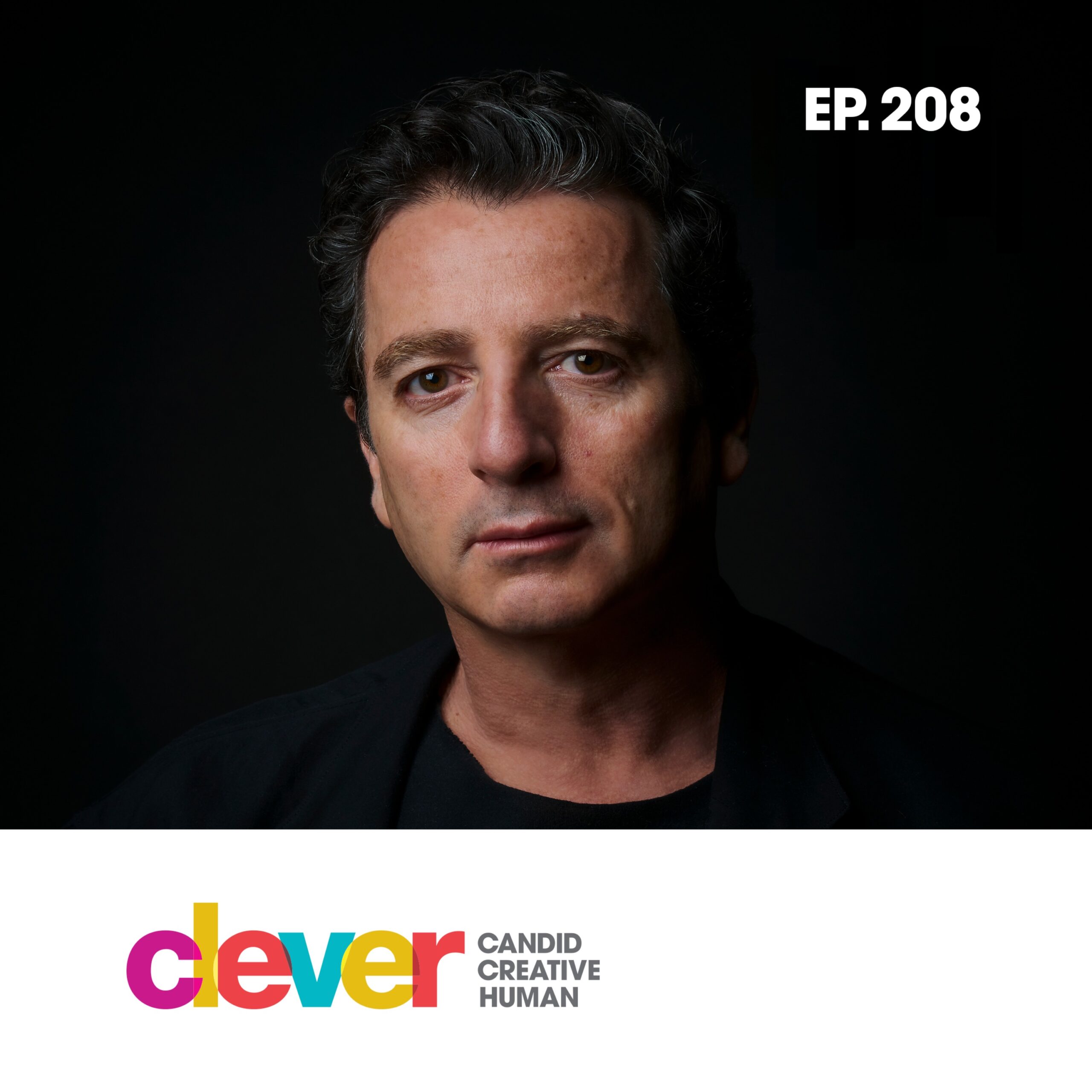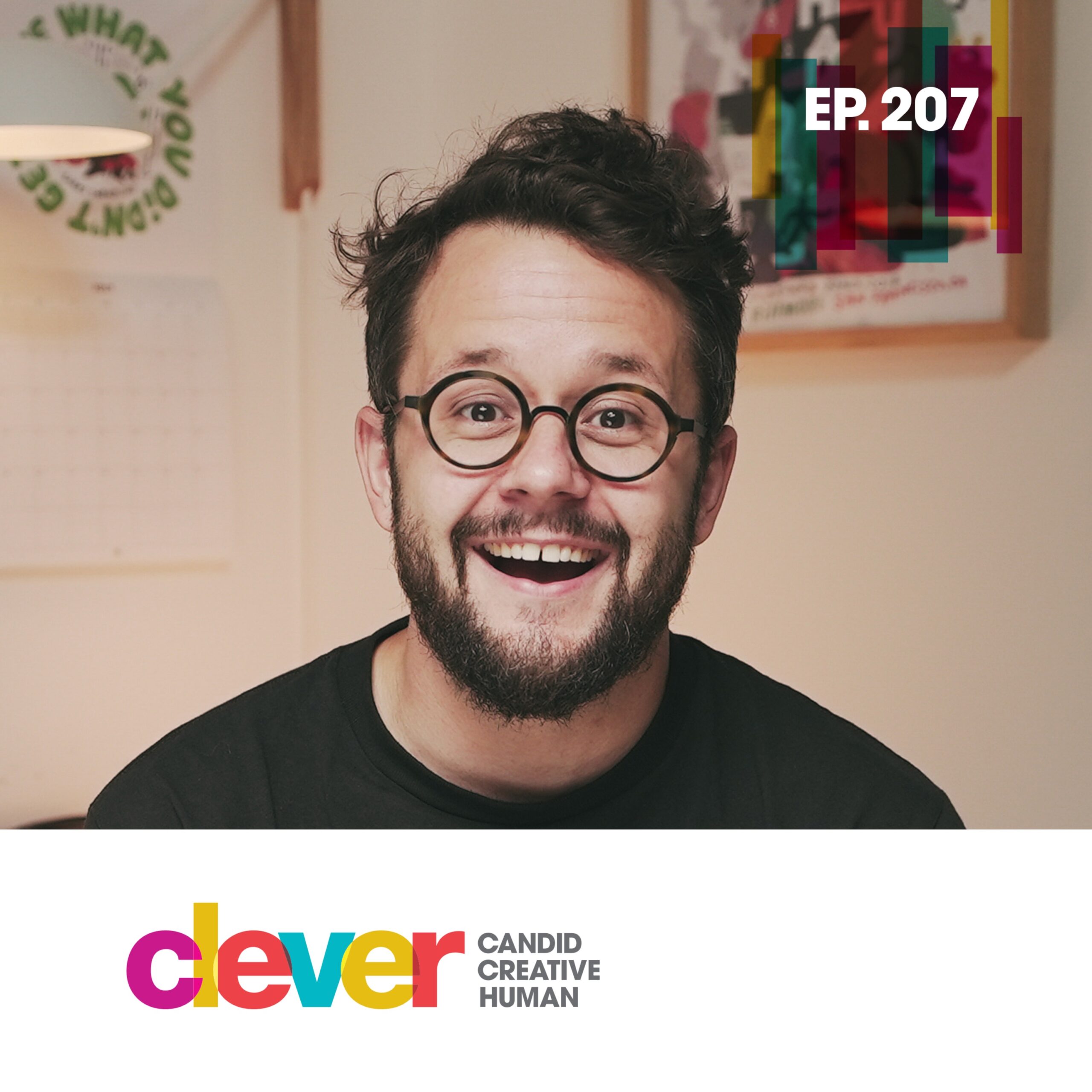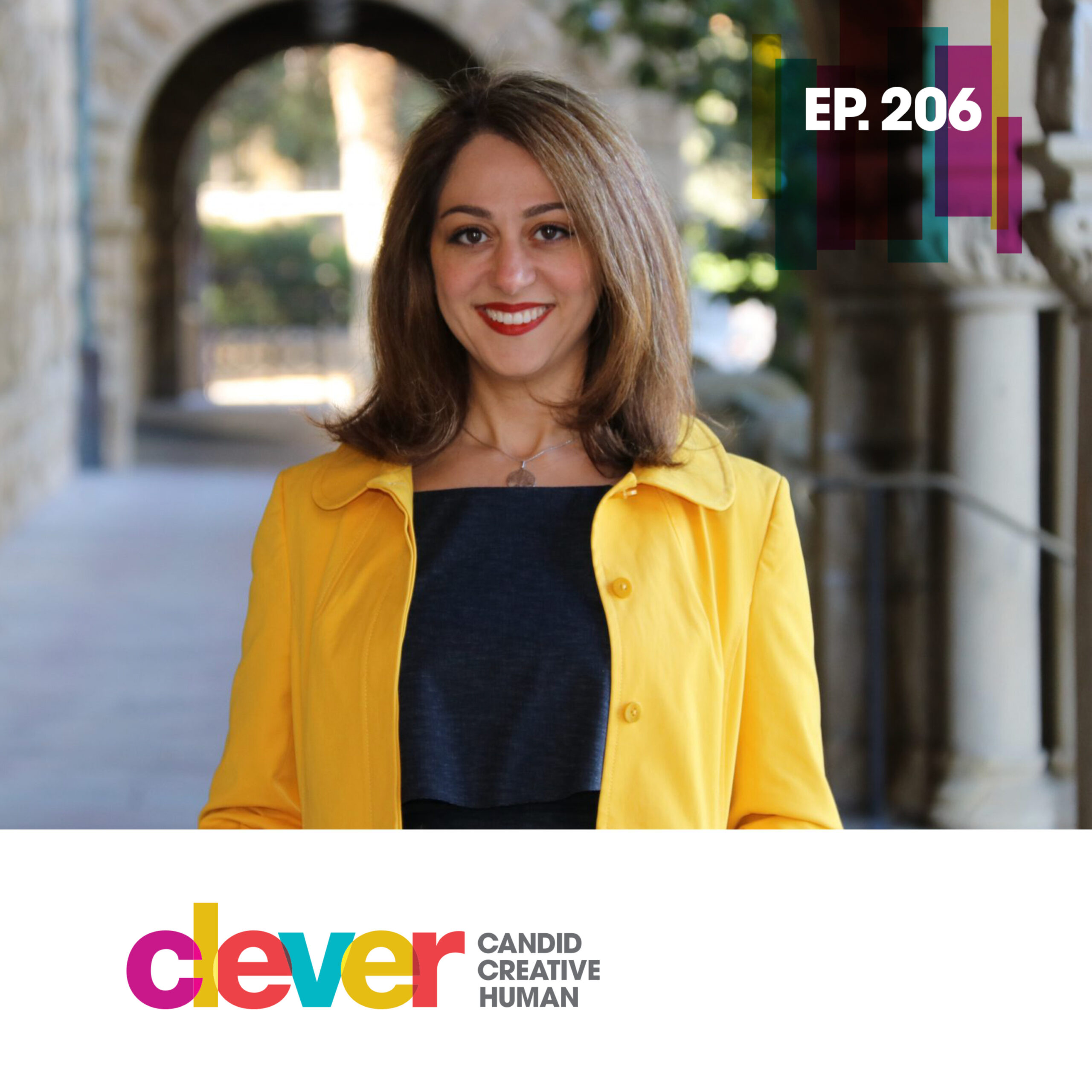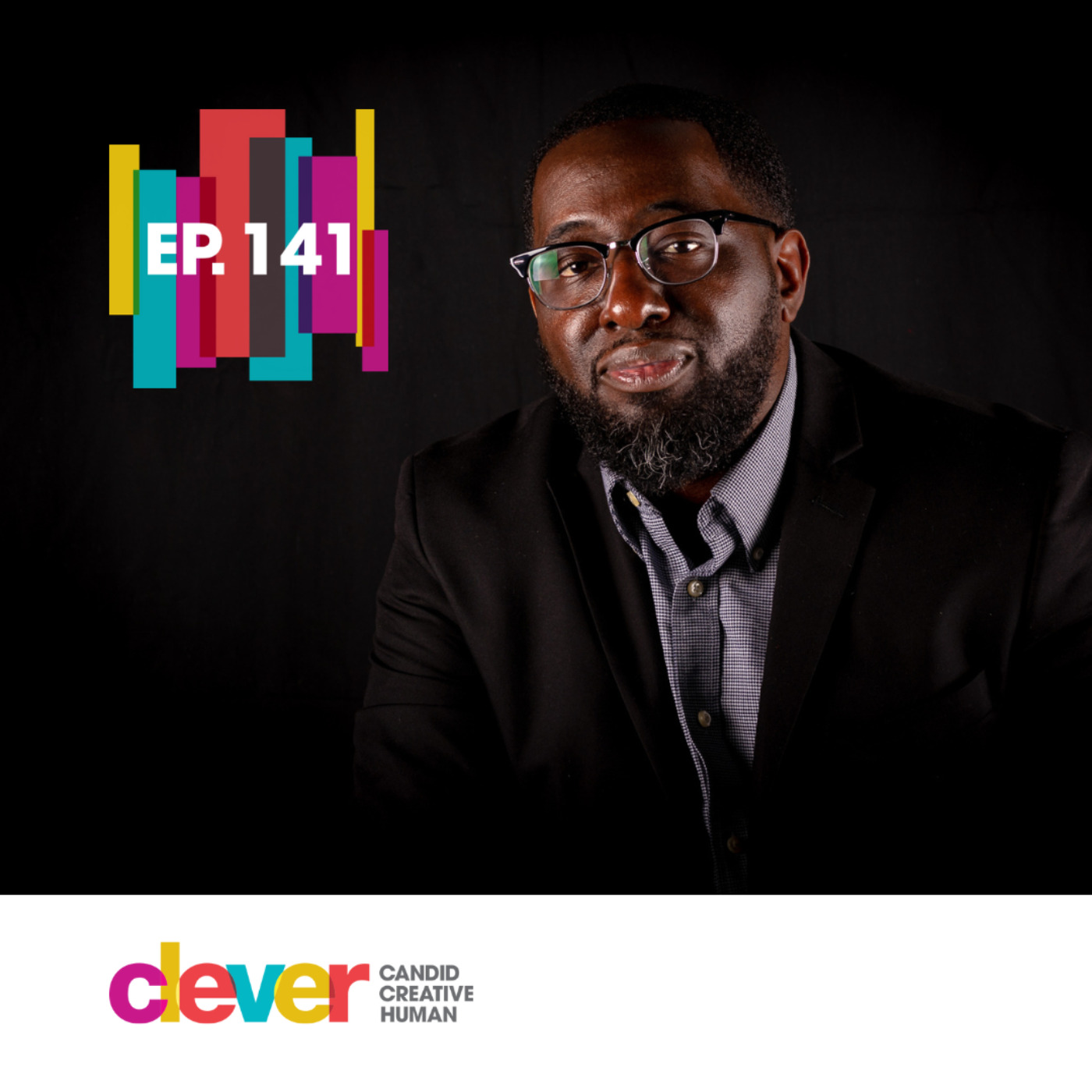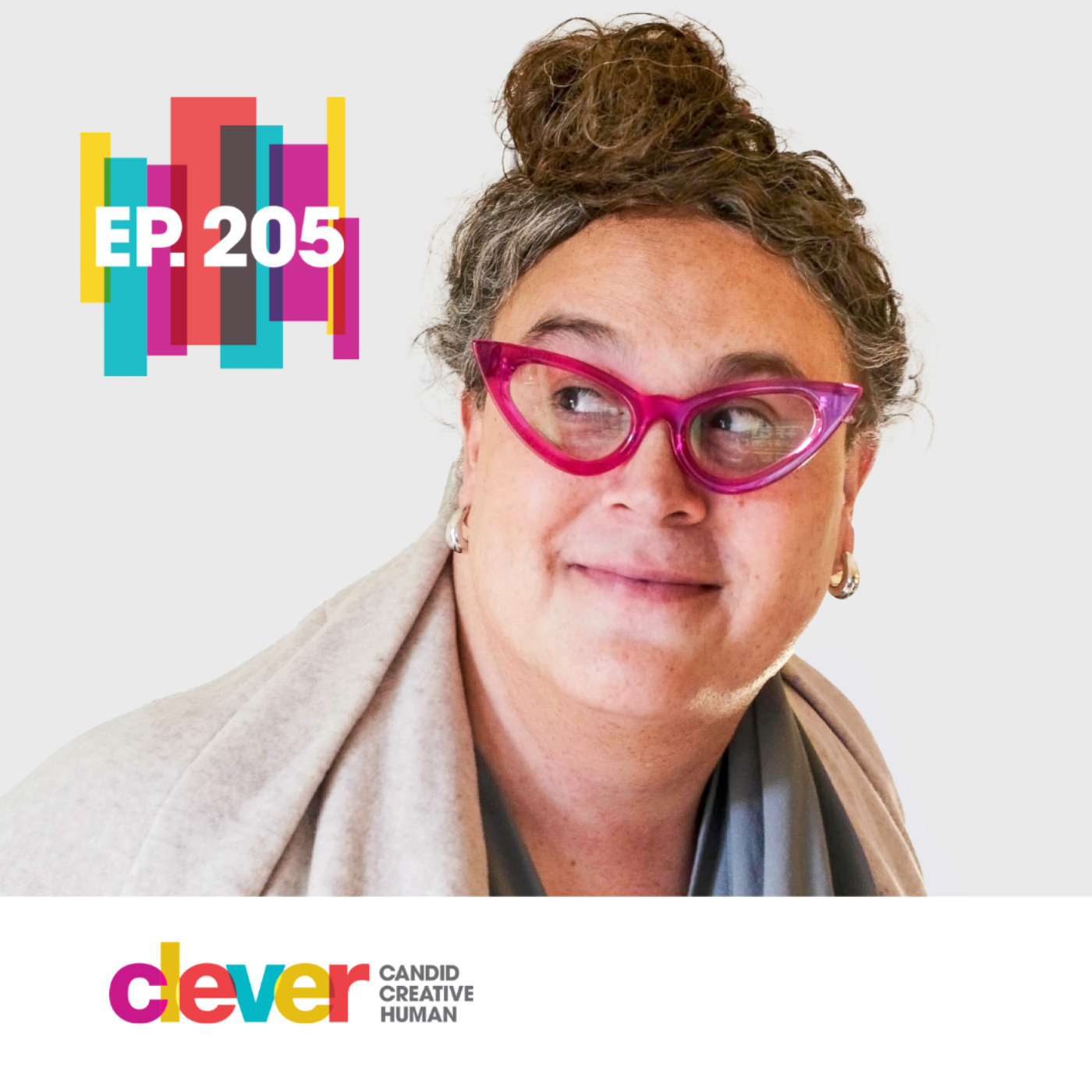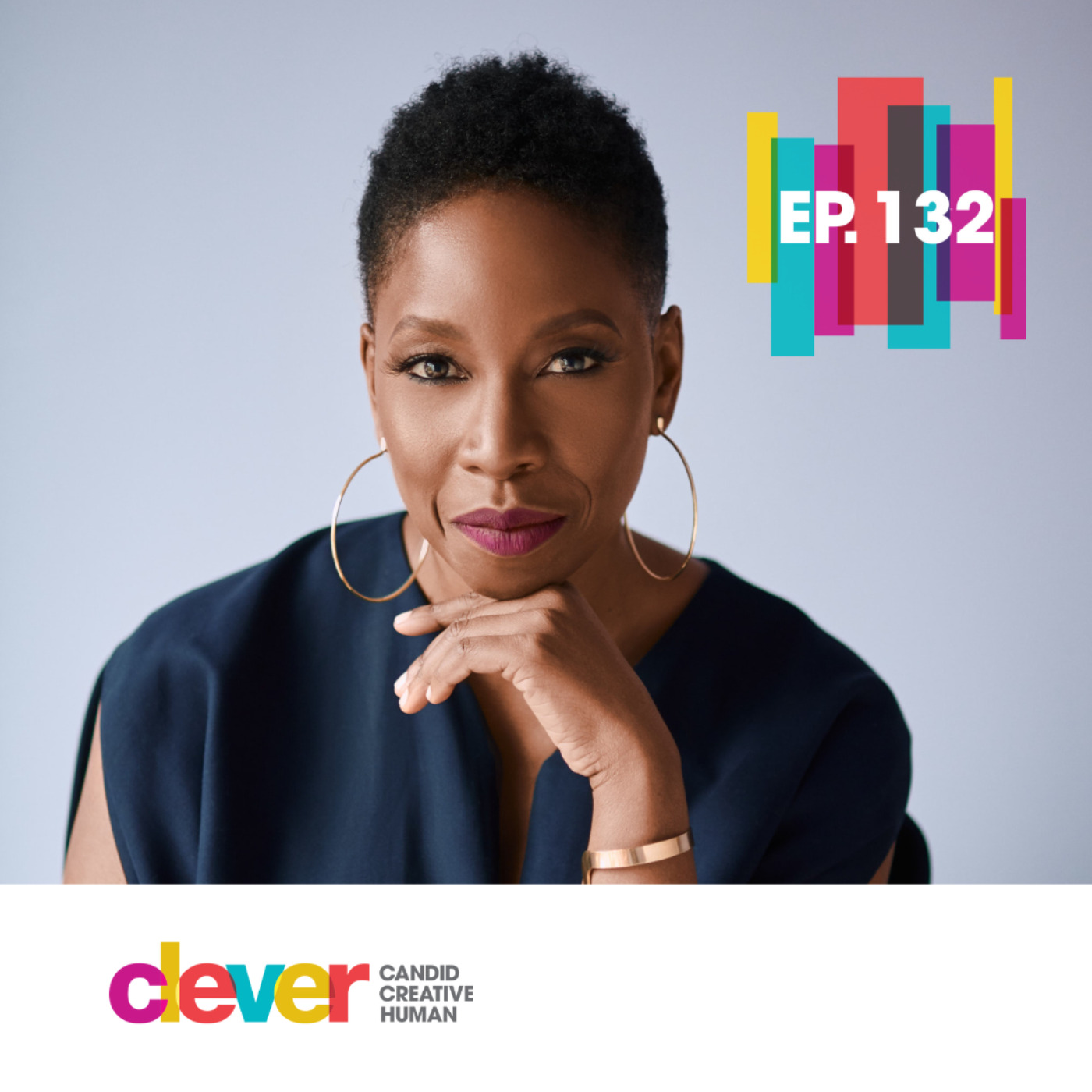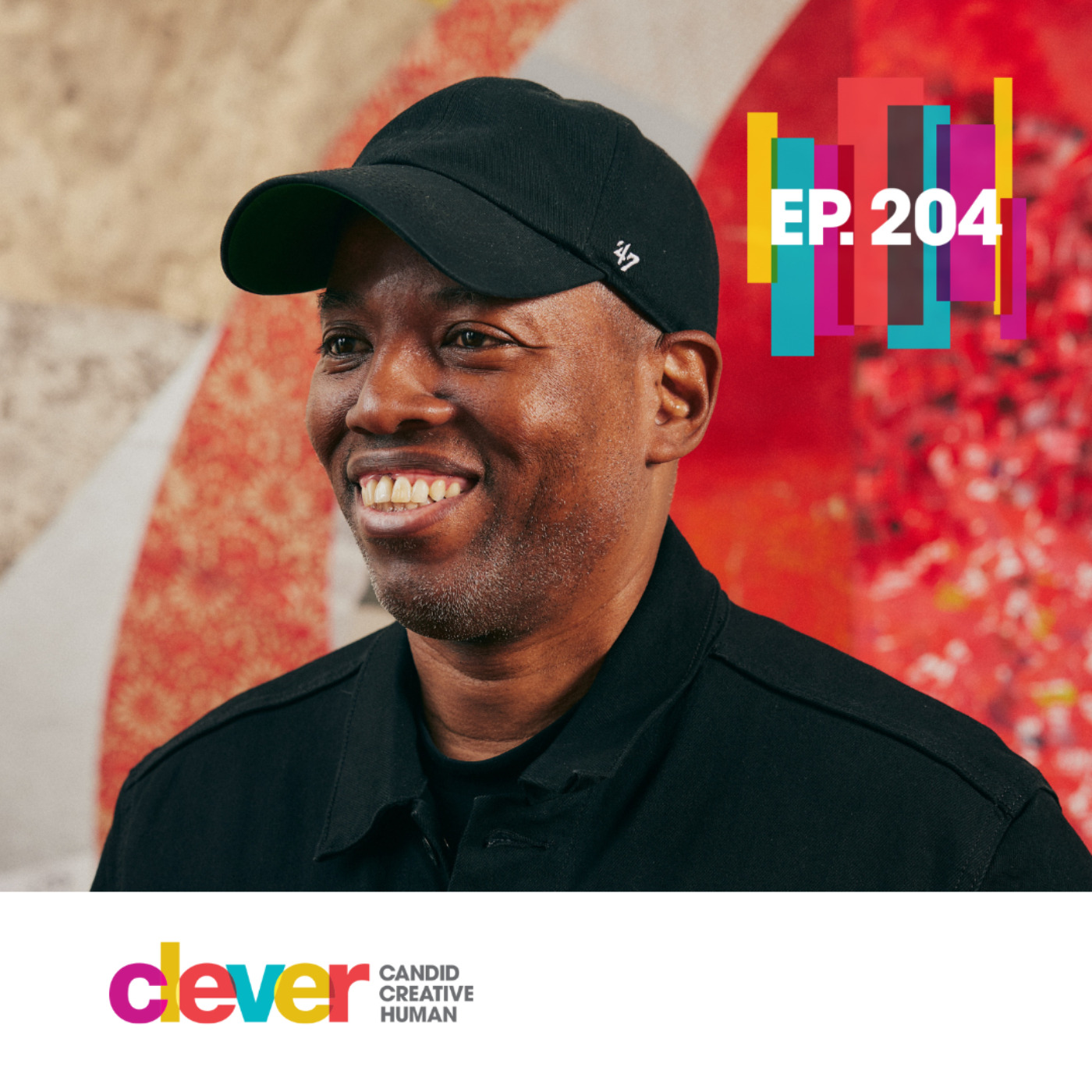Only child Cheryl Durst grew up with a tribe of imaginary friends at her side. Her scientist mom and professor dad encouraged this, since it helped with her stutter and soothed her loneliness. A deep love of learning and art pulled her to the Smithsonian museums to work as an educator, before joining IIDA over 25 years ago! At the helm of IIDA, she’s moved interior design forward, as a profession and as a value to society.
Images, links and more from Cheryl!
Please say Hi on social! Twitter, Instagram and Facebook – @CleverPodcast, @amydevers,
If you enjoy Clever we could use your support! Please consider leaving a review, making a donation, becoming a sponsor, or introducing us to your friends! We love and appreciate you!
Clever is hosted & produced by Amy Devers, with editing by Rich Stroffolino, production assistance from Ilana Nevins and Anouchka Stephan, and music by El Ten Eleven.
Amy Devers: Hi everyone, I’m Amy Devers and this is Clever. Today I’m talking to Executive VP & CEO at IIDA, Cheryl Durst. IIDA is the International Interior Design Association, which supports design professionals, and advocates for advancements in education, design excellence, legislation, leadership, accreditation, and community engagement with a global reach and over 15,000 members, it is certainly a major force in the design world. Cheryl has been in this position of leadership at IIDA for a remarkable 25+ years – and in that time she has pulled it back from the brink of financial ruin, and spurred progress and expansion of the interior design community through the creation of important programs like Design Your World, which serves to expand and diversify the pathway to creative professions by way of community outreach, and providing education and accessibility to youth who traditionally wouldn’t have understood it to be an option. In addition to leading, educating, strategizing, and breaking down barriers, she’s also an exceptional communicator and charismatic presence who deftly deploys the power of storytelling to express the value of design in ways that are both meaningful and digestible. One of the ways she does this is through her podcast The Skill Set. And even though Her background is in journalism, economics and education – she uses all of this combined with the principals of design, move interior design forward. Here’s Cheryl…
Cheryl Durst: Hi, I’m Cheryl Durst, I am the Executive Vice President and CEO of IIDA, the International Interior Design Association and we are headquartered in Chicago.
Amy: I always like to go way back to the beginning, the formative years. I’m wondering if you can paint the picture of your childhood for me.
Cheryl: I was born and raised in Toledo, Ohio. I’m an only child. My parents were the super, analytical, incredibly smart human beings. My mother was a microbiologist and a research scientist who specialized in infectious diseases. Would I have loved to have talked to her about the few years we’ve just endured through the pandemic?
Amy: I bet.
Cheryl: My father was a college professor and then went back to the classroom, was a teacher and an elementary school principal for the remainder of his career. He felt that he would be more effective in the classroom. So I am the daughter of a scientist and an educator and I ended up being this creative, story-telling, not as linear and logical as my parents. And because I was an only child which I always consider super integral to the person that I am, I’m comfortable and familiar with solitude and comfortable and familiar with living inside of my own head. Most kids I think have one imaginary friend, I had six. And they all had personalities and backgrounds. Early on I learned the power of story-telling. I made up backstories for all of my imaginary friends and lifetimes for them and pursuits and professions. I think I populated an entire village with my imaginary friends. It sounded and felt odd to me at the time, and it makes so much sense to me now, which I think for a lot of people when you think back to things that you did or said or reacted or responded to in childhood, all of a sudden at a certain point in life as an adult it makes sense.
Amy: What did your dad teach?
Cheryl: He taught elementary education and sociology, so he taught people to be teachers.
Amy: This is at the college level?
Cheryl: Correct. He went back to the classroom and taught history. Taught American history, world history. He was an athlete, it’s how he got to college. Both my parents grew up in a small southern town, they both went to HBCUs and my dad was the first person in his family to get a college degree in his route. He ran track and played football, so athletics was his route to college. He had a four-year scholarship, so like so many people who are athletic, you end up as a gym teacher at some point in life.
Amy: (Laughs) Mhm. So were academics stressed by your parents in your youth?
Cheryl: Amy, I wouldn’t even say ‘stressed.’ It was just a fact of my life. Learning and education, it was more an imperative than a mandate. I didn’t know there was any other option. Except to pursue education and higher education. I don’t mean to make it sound like a grind, I loved learning and both my parents were exceptional teachers so they made learning a joy. I reveled and relished having an active, curious mind. They absolutely encouraged curiosity and saw that as a key to a future for me.
Amy: Did they invite your imaginary friends into the family dynamic as well?
Cheryl: No one has ever asked me that before (laughs) so thank you and they did. You know, my imaginary friends, as ironic as it sounds, they were a part of my reality and so my parents acknowledged that. Now they certainly didn’t put six additional place settings at the table. But they would ask me about my imaginary friends. I see it now as part of the craft of story-telling that they encouraged, they would ask me about my imaginary friends. As a child I was a profound stutterer and so one of the things that my parents did is by encouraging me to talk and get comfortable with talking so that words lived comfortably, always words lived comfortably in my head, they didn’t live so comfortably in my mouth and coming out of my mouth.
My parents wanted to encourage that same level of comfort that I had with the narrative and with lexicon and with words so they encouraged me to talk and to tell stories and it might be about an imaginary friend or how was my day. I was a shy child and it could have been a catalyst of just being a profound stutterer, I did not like to talk because, again, the words wouldn’t perform the way they were supposed to.
So this crippling shyness and this profound stuttering condition, you know, it does not make for a talkative child but they encouraged me to have conversations that I was comfortable with and actually encouraged me to talk to my imaginary friends. There was much less of a burden of being corrected or criticized when you’re talking to imaginary friends if that makes sense.
Amy: It totally makes sense and I think that’s very generous and profound of your parents to sort of understand that there’s so much. Parenting is a whole thing, right?
Cheryl: Isn’t it.
Amy: But there tends to be a lot of encouraging of children to conform to a universal reality. And in validating your particular reality and giving you a set of friends that you had already made for yourself but not making you turn away from them, they did give you that outlet for you to practice your speech and to practice your story-telling. And I’m wondering if you still are visited by these imaginary friends sometimes. And if so, what are the times that call them forth.
Cheryl: Occasionally I think I can sometimes hear them in the edges of my brain offering encouragement. When I lost both of my parents I found some solace. I went back to my childhood home and it’s that super difficult exercise that anyone who has lost a parent has when you’re going back home to clean out the house, right, and to gather the things.
And so I was revisiting so much of my childhood and it’s almost like I felt a presence that they were there kind of crowding around me because again, as a fearful child, those imaginary friends represented my tribe. They were the folks who held me close and dear and almost protected me. So if I were profoundly Catholic I would say they were guardian angels.
I think we all have a version of what that imaginary population is like that keeps us going, that keeps us real, reminds us of who we are, and they’re there when we need them. I know when I’m going through a moment and I may not be a particularly religious person but I am certainly spiritual, so whatever form those imaginary friends take, they’re always there to listen to me and every now and then they offer me some words of advice, too.
Amy: I like that. I’m glad you said ‘spiritual’ because that’s sort of leads into my next question which is sure you made up back stories and you sort of fleshed out these characters, but do you believe there was an underlying energy that brought them to your life and you gave them narrative substance but the energy was there?
Cheryl: Absolutely, Amy. I think I probably gave fuel to them and gave them form and shape. I went to Catholic school for 12 years and I was probably more fascinated by the lives of the saints than I should have been (laughter) and so again. It’s why I was fascinated by the lives of the saints, they were great stories, right. And I think that probably in my own small childlike way because I was as a kid growing up in the 60s, so I didn’t have baseball cards but I had saint cards (laughter) and you would kind of trade your saint card with other kids at school. It’s fascinating the things that human beings create that either are lessons for us, that are roadmaps for us, that are milestones, or markers.
The mind is such a powerful and incredible thing. Sometimes it lets us down, absolutely. But also the mind is what keeps propelling us forward and it doesn’t just house intellectual things. It houses our soul and our spirit and our aspirations and our fears. I still see my imaginary friends as a manifestation of kind of all of those things.
Amy: It sounds to me like not only did you have this tribe but you also had endless opportunity to make meaning with this tribe. Maybe you can describe what that feels like as you’re growing up into teenage years. At some point it becomes socially not acceptable, to go to school with a whole tribe of imaginaries. (Laughter)
Cheryl: With all of your imaginary friends in your binder?
Amy: Yeah. (Laughter)
Cheryl: I grew up in the 60s. As a young black child growing up in a period of turbulence and I went to a private Catholic school. I was not the only black child in that school but there were a handful of us. Loneliness was a thread. I was super conscious of not seeing a lot of folks that looked like me. I was nerdy. I had this speech impediment. But one of the times when I would not stutter is when I would spell and so my parents would put me in every spelling bee possible and I felt a sense of accomplishment and confidence.
But you know when you’re nerdy and you have a speech impediment and I wore glasses and I had orthopedic shoes and at some point in life I had braces. It was kind of a whole quad-fecta of things. I had all this apparatus to ultimately correct something so I was super conscious of being different. Whether that was different as a girl or different when it came to race or different because I preferred to curl up in a corner with Nancy Drew rather than listen to the radio or go out and have fun and play kickball.
That conscious realization of ‘otherness’ or ‘different,’ again it stood me in such good stead later in life but when you’re going through it it takes a certain amount of wherewithal and courage and stick-to-it-aveness which again my parents as very middle class black folks who were ambitious and always wanted the best for me and they were very conscious that as an only child I had another degree of loneliness. I was also very conscious of living up to their very high expectations of me as well, and I loved a good nap because being all of those things, even as a child you get tired.And sometimes you just want to put your head down and have the world go away for a little bit. That doesn’t mean I wanted to leave the world, but sometimes I needed the world to be a little quieter than it was.
Amy: I feel you on that. In addition to all of these things that you’ve just described to me, do you think that you feel things more deeply than the average person? Or that you process information on a more volumes of input or smaller particles of it more deeply?
Cheryl: I remember a story that my mom told me when I was about six and we took a family trip to New Orleans and my entire family oddly enough, we love cemeteries. They’re just very evocative and they’re kind of cool to walk through and visually they’re very cool. And New Orleans, I can’t think of a better place for a good cemetery, right? With all of those above ground mausoleums. So we were walking through a cemetery and my mom looked over at me and she saw tears running down my cheeks. She said, “Oh I know, this is really sad.” We were in a section of the cemetery where most of the folks who had passed away had yellow fever and there was a marker that I was standing next to and the little girl was my age, she was five or six years old. I remember feeling that, but my mom said to me she asked me, she said she was talking about how sad it was and she said, “I know you’re sad.”
And I said, “It is sad,” but the statue at the grave, the marker, there was an angel that was just beautifully sculpted and the angel was wrapping her arms or her garment, but she was encircling the statue of a little girl. What I said to my mom was I said, “No, mom. Yeah the story is super sad but look at the curve on the arm of the angel.” And it was that curve in marble that looked so warm and human but I knew it was marble, that made me cry. My mom said at that moment she knew I had the soul of a creative person.
Amy: That makes a lot of sense. That does.
Cheryl: So I felt a curve on a statue. I remember we got back from that trip and my mom immediately enrolled me in art classes at the Toledo Museum of Art and I felt color and I felt music. I took ballet classes. And my parents responded, even though they weren’t creatives in that sense of that word themselves, they saw it in me, nurtured it, and developed it.
Amy: That’s beautiful. I think sometimes people that don’t consider themselves creative or haven’t tapped into it, everyone is creative, right. But they just haven’t sometimes tapped into it or owned it within themselves. And if they don’t see it within themselves sometimes they have a really hard time seeing it in their children. So to give you all of the avenues that you might need to explore that and to develop it is so therapeutic because it’s not even just about that you might grow up to be an artist. It’s an understanding that art enhances your life and sort of builds on this transcendent connection you have with the world.
Cheryl: And my parents both knew. I remember, and again they were both super logical, analytical people, but I remember at dinner one night having this conversation. I was a bit older and I had asked them why they had so encouraged the arts in my life. It was something that they certainly hadn’t had in their lives growing up in a small, segregated southern town. My dad quite simply said, “Like water and like air, you need this.” That was it. That was the answer. You need this.
Amy: It sounds like you felt very understood.
Cheryl: I did. I certainly went through that moment when you’re 13 or 15 or whatever the magic age is…Where like, ‘oh they don’t understand me,’ but I felt so seen and heard and loved and understood and appreciated. They were such incredibly special people who had had their own share of difficult times growing up and whatever that saying is, we always want to make things better for our own children, give them things that we didn’t have. There are moments that I have where at a young age I didn’t appreciate what they were doing for me. I felt it, but I don’t know that I intellectually appreciated it. I’m so glad I got to the point as an adult where I was able to thank them for what they did for me.
Amy: Yeah. Yeah, that’s so nice. And yeah, when we’re kids you don’t know what you don’t know. You’re just going through it, so it’s beautiful. It sounds like you felt seen, heard, and understood, but also given a lot of space to grow into whatever it is that you’re growing into.
Cheryl: Yeah, and that stays with me so much now, Amy. Both of my kids went to art and design school. Both my kids are filmmakers and my daughter went to Santa Fe University of Art and Design and she works for Nickelodeon now. My son graduated from RISD and he is a film editor. With both of them, going with them to freshman orientation and going with them to first week of college and then subsequently to parents’ weekends and all the things, I was super conscious of how many kids in programs of art and design, aren’t seen, heard, appreciated, or supported by their parents.
It never occurred to me to not be that parent who is at freshman orientation, to not make that trip to Bed, Bath & Beyond and get that damn bedspread (laughs) and shower shoes and the mini fridge and move a child into a dorm. With both of my kids I saw so many kids who did not have that, who were doing that on their own. Who had emancipated themselves from their parents for financial reasons so that they could qualify for financial aid simply because they had chosen a life and education and a career in the arts, that their parents weren’t showing that support.
It’s prevalent, obviously being the CEO of a design organization I hear these stories all the time about parents who encourage their children in other career directions and who we are and what we do is so intrinsic to self and so bound into our brains and to have that rejected at an early and impressionable age, the crushing agony of that or just the crushing of not being understood, it leaves an indelible impression.
Amy: You said it better than I could and I appreciate that in the position that you’re in now, that’s something that you have a deep understanding of because I do think one of the important narratives that we in the creative fields needs to counteract is this narrative that creativity is somehow not a secure profession to pursue. Therefore in their well-meaning intentions parents frequently dissuade their children from the fullness of themselves in an attempt to guide them towards something that is going to be more secure. But they don’t even kind of get that they’re amputating their child in a certain way.
Cheryl: Yeah, ‘amputate’ is such a perfect word. When you listen to the designer or an artist describe what they do, it is indelible. It is intrinsic to their personality. The fact that you say, “I am a designer,” I hate putting value or judgment on this, but that’s slightly different than saying, “I’m an insurance adjuster.” I can’t quite equate the two and there may be an insurance adjuster who is listening and won’t like what I just said, (laughs) but ‘I am a designer’ says as much about who you are as a human being as what you do for a career.
When that is denied that is someone turning their back on your path, on your soul. I feel that so deeply because it’s 25 years I’ve been the CEO of IIDA and I’ve heard this story over and over again from students, from designers whose parents did not support them as students or didn’t understand. I feel like designers are on a continuous struggle to explain the viability and vitality of what they do and that becomes a larger question when we’re talking about equity. In the creative fields and in particular in design because if you’re first generation in your family to go to college, if you’re from an immigrant community, your parents will in all likelihood persuade you to choose a high net worth career, something that is understood in aggregate, something that supposedly has dignity and respect in society. That doesn’t always, for a lot of people, add up to a career in design.
Amy: Absolutely. I’ve heard that story over and over again in the people that I’ve interviewed for this podcast, but I’m also faculty at Rhode Island School of Design and I see it played out again and again. I know that with all of your story-telling prowess and finesse, one of the great missions of your life, is to help to communicate the value of design out through beyond preaching to the choir, but out to the masses so that they understand just how much everything is designed. Everything in the built world has been designed and if it’s designed unintentionally then it has unintentional consequences. But if we design it intentionally and we’re understood and valued for that that we’re contributing to the built world and that that’s contributing to your wellbeing and your experience of the built world, then we’re in a more balanced, harmonious ecosystem.
Cheryl: I started thinking really differently, Amy, about my vocabulary and lexicon around design and trying to explain it to other people and the impact that it has on their lives. Simply saying that ‘somebody designed this,’ I found wasn’t moving the needle enough. When I shifted that phrase to ‘someone thought about this,’ which that’s an illuminating moment for a lot of people. There’s so much randomness in life, right? So we ascribe a lot of things to random. Things just happen.
Amy: Yeah, I think I grew up thinking that forks magically came from a factory with no human involvement. (Laughs)
Cheryl: Exactly, that’s a great example. But someone thought about three tines versus four and how that fork feels in your hand, what is the experience of encountering an instrument. I always wonder who created the first fork. Or it’s like how did we come up with a potato? Who dug that out of the ground and decided that they’re going to eat that? (Laughs) So things organic and things inorganic, I always kind of wonder about the origin stories. But talking to particularly children about what design is and how it impacts their lives starting with that simple fact that somebody thought about the shoes that you have on, that ends up being a great entree, a great entry point to having a conversation about design and why design and then why design matters.
The other side of that coin is dignity. Design makes us most human and it encourages humanity and it betters humanity. It typically shouldn’t or doesn’t other humanity, so depending on the audience I try to be very sensitive to the relationship that the audience has with design and start the conversation there.
Amy: That is why you’re so good at it. Meeting people where they are and then helping them get to where they need to go. I think that’s really brilliant. Frequently in trying to communicate the value of design we tend to over-complicate it because we don’t start with the idea that design is a loaded word and people have their own impressions of what design means. So if you circumvent that from the very beginning you can get them to a more honest and open-ended understanding of what design is.
Cheryl: Absolutely. The word holds such power. It’s a talisman for some. It’s frightening for others. I find that for a lot of people it’s often loaded with power and privilege and if power and privilege aren’t resident in your own life or in your own heart you will be intimidated by design or ignore it completely and think that it has nothing to do with you. I find that difficult and dangerous as well because you can’t think that design has nothing to do with you. It has everything to do with you.One of my favorite mantras is ‘design is about what happens on the receiving end.’ I don’t think a lot of people think about the fact that they are on the receiving end of design whether they know it or not. You don’t have to be a client to be on the receiving end. So within the profession of design, understanding or maybe rethinking, re-imagining, doing a charrette (laughs) around our own vocabulary. I think about when my son, Gabe, was at RISD and I certainly had a lot of conversations with faculty and the team there about foundations and even how we teach design. I remember Gabe telling me that first year was his toughest year at RISD.
He shares that in common with a lot of students where foundations become something to be endured, it’s a badge of honor when you survive it. As opposed to this tremendous incomparable learning experience. How we think about how design is taught and how it’s experienced, just as a profession we need to consider. It’s not an ordeal and it’s nothing to suffer through. You don’t have to be a starving artist. We’ve set up a lot of expectations around design ourselves and we’re not doing a service to the public within that.
Amy: I agree with you and I am a little bit optimistic that some meaningful shifts are happening in that direction. You described a ‘teenagerdom’ that included braces and glasses and needing a nap. I totally, totally appreciate that. Then somewhere in there you also put yourself on a path to study journalism and economics at BU but you’ve already demonstrated yourself to be very creative and interested in the creative arts. So the choice to study journalism and economics, now you and I both know you can get really creative with both of those so they’re not not creative endeavors.
Cheryl: Absolutely, yeah.
Amy: But it does seem interesting to me that you didn’t go to a specifically artistic major.
Cheryl: So here’s the irony in that, when having those kind of career kind of conversations with my parents and as much as they encouraged me in the arts, when my father said to me, “We’re thinking about college, what do you want to major in,” and I said, “Art history, I want to be a curator, I want to be in a museum and manage a museum and acquire art and teach people about art.” My parents looked at me and it was a pivotal moment. I was about 16 or 17 when we had this conversation and it was a super pivotal moment because I was feeling secure in the fact that they were going to support me in a career in the arts.
So when I said ‘art curator’ they said ‘absolutely not.’ I was floored and I said, “Why not? I’ve had this amazing life.” I was learning to be a junior docent at the Toledo Museum of Art and all these great things. And my parent said, “We don’t know anyone who is a curator and you’ll live a very lonely life. It’s a tough career. You get ahead by connecting. The museum world is small. It’s populated by privileged people and it will be a hard life for you. Everything we’ve done for you; we don’t want you to have a hard life.” It was like, ‘woah!’
Amy: That does feel like a tidal wave.
Cheryl: Right? It was a 180 from what I had known. They weren’t doing it to be mean or to be cruel.
Amy: Not at all.
Cheryl: In their heads they were protecting. My father said, “Think about what you do really well. You’re a phenomenal writer, you’re a phenomenal communicator.” He is the one who actually helped me understand I like taking arcane bits of information and translating that into easily accessible information. I had interned a couple of summers. In Toledo was the homebase, corporate headquarters of Owens Corning Fiberglass and I had interned in their corporate communications department.
I helped write a company newsletter. I wrote about pickle tanks and (laughs) that was when Pink Panther debuted with the insulation. I loved taking that really ridiculously nerdy chemical information and translating that for homeowners and home buyers. My father said, “That, corporate communications, there’s a real future for you there.” Then he proceeded to explain to me how people needed information written clearly and coherently for them and that super appealed to me.
Amy: Yeah.
Cheryl: The love of art and art history never left me. I minored in art history and at the time I entered BU and that was a very deliberate choice. It was the 80s, I wanted out of the Midwest, I was ridiculously influenced by the preppy handbook. (Laughs) The things we used to make big life decisions are utterly ridiculous sometimes. I wanted nothing more than to wear khakis and layer some Shetland sweaters over three shirts with the collars flipped up. (Laughs) So off to Boston I went and BU has a phenomenal journalism program and I was able to double-major in economics.
What I found fascinating about that was it was the time when we were becoming more financially literate as a culture and a society, learning more about personal investing, 401Ks were coming to the forefront. So I was kind of pursuing this path of taking things that people don’t typically understand and making them accessible. I wasn’t interested in the crime beat, I was sort of fascinated by obituaries, throwback to the whole cemetery thing.
Amy: (Laughs) Yes.
Cheryl: But finance I found absolutely fascinating and particularly communicating. I took a course in women in the stock market and how we as women aren’t taught to be financially literate. Boys are given an allowance and explained how to save. Girls are given an allowance and just told to put it away. The seeds of understanding race and gender and differences in how we consume information started to be really fascinating for me. If I could have quadruple-majored in culture anthropology I probably would have done that. Layered that.
Amy: Oh, I can see you. I can see you as a cultural anthropologist. You still are. You’re operating as a cultural anthropologist in all your different facets.
Cheryl: What motivates, and the why. I have always been fascinated by the why. So WBUR which is an NPR station operated out of Boston University, BUR, Boston University Radio, I had a small show on investing and financial management and saving, and I loved it. I don’t ever regret going down that path.
Amy: That was your first podcast? Well radio show, was back then?
Cheryl: Yeah.
Amy: Man. From a stutterer to a radio personality, look at you.
Cheryl: Uh-huh. No, it was on at 3am in the morning (laughs) and maybe two people heard it, but there I was. Again, forever grateful to my parents even though they didn’t encourage me in what I thought I wanted to, the path that they put me on in this gathering information, packaging it, packaging it into a consumable narrative and then communicating it, whether written or in presentations. I am forever grateful to them for pointing me in that direction. But the art and the art history piece never left me. The entire time I was in Boston I volunteered at the Isabella Stewart Gardner Museum. After college I moved to Washington D.C. and the Smithsonian has the most incredible volunteer program. I enrolled in the docent program there and you essentially have to take a nine month art history course.
So I was a docent at the Museum of African Art, the Hirshhorn Museum which is the contemporary art museum in the Sackler Gallery which is Asian art. On weekends in D.C. I would give tours and I would have tour groups. Even though I wasn’t a paid staff member of a museum, I was a volunteer and that was also a real first true volunteer experience for me and seeing how volunteers are managed and encouraged and taught. The pieces of who I became later in my life, those seeds were planted very early on. But for me everything is predicated in curiosity and education and communication.
Amy: Yeah, I can see that. Even in that last little soundbite you distilled everything we’ve talked about so far down into (laughs) these three sort of key buckets that are what you pull from in order to do what you do. I do what to talk about you’ve been in the position that you’re in for 25+ years so that’s a long arc and I want to get into that but is there anything more from those first few early professional years before you became the CEO of IIDA that is important and pivotal in terms of your journey now?
Cheryl: I was a teacher. I taught high school. (Laughs) I was a substitute teacher.
Amy: Oh, a substitute teacher, that’s even tougher. (Laughs)
Cheryl: Yeah. So again my parents, ever mindful of life, and I’m sure your parents probably told you the same thing, particularly as a women you should always have something to fall back on. I amassed enough credits to qualify as a substitute teacher. When I graduated from college there were very jobs. I feel like there’s always a recession going on and I didn’t want to move back home so I moved to Washington D.C. and my parents said, “We’ll support you for three months. You’ve got 90 days, figure it out, find a job. If everything falls apart you know you can always come home.”
Well I’ll be damned (laughs) if I was going back to Toledo, Ohio so (laughter) I became a substitute teacher. I walked in to sub in a 9th grade class for a teacher who had the flu and she never came back. Marion Barry was the mayor of D.C. at the time and D.C. public schools were just the hottest mess ever. I had a freshman homeroom and I taught advanced placement English. I also, with a group of other teachers, we banded together and we took our kids on field trips and guess where I took my kids. I took them to museums. And I discovered the high school that I taught at was in a fringe-ish neighborhood as we call them, so the school was populated with haves and have-nots, and whether the kids were have or a have-not, I found that many of them had not gone to the Smithsonian Museums. If you live in D.C. one of the best free resources that you have are any one of the 12, now 15 I think Smithsonian Museums.
So we would regularly take our students not just to Air and Space or Natural History, but to the Hirshhorn and to the Portrait Gallery and expose these students who all lived within no more than 2 miles of those museums. Expose them to the incredible world that the Smithsonian Museums had to offer. I had a freshman homeroom and average age is about 13 or 14 and he was 16, so older than the average and he had been left behind a number of times.
So I had this policy in my classroom to let the kids move their desks, anywhere you want to put your desk, because I remember what it was like being taught to the majority. Kids, there are so many different ways to learn and so many different ways that kids receive information. This kid was probably about 220 lbs and 6’4” tall so he was big, he didn’t look like the other kids, but he was so tremendously unhappy. His name was Al Smith and my name before I was married was Stubblefield. I talk about being an M through Z. I’m like, “L, we’re both M through Zs. When I was your age I always sat in the back of the classroom too and I was always the tall girl. I’m an S so I sat at the back. I’m going to give you a chance, let’s break out of the alphabet.” If your name was Anthony Adams let’s just pretend you can sit anywhere you want and let’s move your desk. He looked at me super suspiciously because what teacher lets you do that. I said, “Where do you want to move your desk?” He said, “I want to move it forward.” It turns out he couldn’t see. So he said, “I want to sit toward the front but not way far front, and can I sit next to the window?” I said, “Absolutely.” So we moved his desk and of course the other kids saw what was going on and they wanted to move their desks so that kind of started this. Let’s put your desk and when you’re in my homeroom, for 40 minutes you can sit anywhere you want to.
So Al moved his desk next to the window, a little further front, and he was in the sun. He was in the sunshine and his grades started to improve. His behavior started to improve. Other teachers said, “Okay, how did you get through to him?” I said, “I let him move his desk.” He became a better student and a happier person. When he graduated I said, “Al, what is it about high school that you’re going to remember?” And he said, “You let me sit in the sunshine.”
Amy: This is interior design.
Cheryl: That is design.
Amy: Yes.
Cheryl: And that stayed with me. Al had the power over his environment at his fingertips. He moved himself into fresh air and sunshine. Other students saw that happening and realized that they had the power to have impact over their environment. Al is a mechanical engineer now. So that story for me helped inspire what 30 years later became IIDA’s Design Your World program. How do we talk to kids? I don’t care whether you are from Georgetown or the wealthiest neighborhood, or whether you’re from the south-side of Chicago. How can we ignite a spark in you that you have power and agency over the world around you? And there’s an entire career that is at your disposal that will allow you to not only do that for yourself but for others.
Amy: Hallelujah. (Laughter) Hallelujah. Let’s get into your tenure as the Executive Vice President and Chief Executive Officer of IIDA. I understand that you were only there for a few years before you became the CEO and then needed to turn around an organization that was in financial free fall.
Cheryl: Correct, yeah. I met my husband in D.C.After teaching I ended up working for at that time, Ref, Canadian wood manufacturer and Ref had merged with Westing House and Shell Walker and Noel. It was kind of the first big merger in our industry and I started working for them as a writer. I was a showroom manager, I wrote product literature. My husband managed the Mart building in Washington D.C. so we had a workplace romance. (Laugh) He was managing the building and events and he was ultimately tapped to run the trade shows that the Mart produced. So that’s how we ended up in Chicago. We moved because of him. A lot of people think we moved because of my job but IIDA hadn’t even been created. But we moved to Chicago, we’d already had our daughter and he came home one day. We were both working for the Mart at that time and he said, “I’ve just heard about this association and they need a Director of Education. It’s a not-for-profit and it’s part-time.”
Having been an only child I knew I didn’t want to raise an only child. I knew I wanted to have a second child at some point and he’s like, “You know, as a not-for-profit you can probably manage working there and having two kids.” It sounds good. So I went in for an interview and I was hired as the, surprise, education again. I was hired as the Director of Education at IIDA and within about 18 months to two years of my being there there was some malfeasance and some negligence that was coming to fore in the association. Some financial neglect. My predecessor was dismissed from her position and the board came to me and invited me to be the CEO. We didn’t know the magnitude of the deficit but we were over $2 million in debt.
Amy: What? But the Director of Education to the CEO with a $2 million debt problem?
Cheryl: Yeah.
Amy: My goodness. Honestly, what a huge vote of confidence from the board as well.
Cheryl: And I was eight months pregnant. (Laughs)
Amy: Oh my god.
Cheryl: With baby number two. (Laughter) So I started digging. I started asking questions and I had worked at IIDA long enough to understand. IIDA had been created in 1994, so we’re actually celebrating our 30th anniversary next year. But it had been created as a merger of three design organizations. In the 80s there was a movement called Unified Voice because there were a lot of disparate design organizations that existed. So a group of volunteers got together to create this effort to coalesce and combine all of these organizations. Three of them ultimately formed IIDA. Early in its history lots of attention was paid to nomenclature and mission and vision, but not to infrastructure. So it was built on not the best foundation, best footing. Right? The sexier things got paid attention to. A lot of people would much rather figure out what your logo looks like than do an audit. No audit had been done and I have to tell you when I began to understand the magnitude of the malfeasance, what I remember saying to myself is ‘this is a design organization and through some neglect it is going to not exist.’ What resonated for me, Amy, is that the public would say, ‘that makes sense, designers know nothing about business so it makes complete sense that a design organization would fall apart.’ I remember saying to myself I’ll be damned if that happens on my watch.
Amy: Thank you for that.
Cheryl: It was a point of pride for me to not let this organization live up to a reputation that a lot of people have about design. Volunteer organizations are as much a business as any other and also at that time volunteer organizations were having a bit of a moment that people weren’t taking them seriously and nobody wanted to work for a not-for-profit. I remember my mom saying to me (laughs) is that I take on things because of pride and I always want to show things in their best light.
Whether it’s a student or a classroom or a profession or an organization, I always want to do my best to make it look good and work well. Not just the window dressing, but to have all the unsexy infrastructure stuff in place. So I had to fix it. I had to fix this place. So many lessons that I learned, I at one point thought that I was going to go back to school and get my MBA and my first five years at IIDA were actually that MBA. But I had to publicly confront this financial free fall and explain to members what had happened because we didn’t want to hide anything. I had to work with the board. The staff at IIDA was over 50 people for a 5,000 member organization so I had to fire. I had never fired anybody in my life and I had to terminate the employment of 40 people, it was ghastly, and then right-size the organization. For the 10, 12 of us that remained I made a commitment to never miss a payroll period. And I was a new mom.
Amy: Man. This is designing your way out of a jam.
Cheryl: Uh- huh. And the fact that I was a black woman leading an organization. The hard part in this entire story, it wasn’t the financial free fall, it wasn’t the fixing, all that I understood, it was when I started getting anonymous phone calls and letters that said, “An N-word should never lead a design organization.” So that happened and I didn’t talk about that for a very, very long time. But that happened.
Amy: I’m horrified. I’m so, so horrified on your behalf. But I guess I’m also not entirely surprised.
Cheryl: There were people who did not want me to do the job that I had, so much so that one of the most threatening letters was retained by the Chicago Police and my life was threatened. Gabe had been born in April so at NeoCon I was officially announced as the CEO at IIDAs annual meeting and I had to have police protection.
Amy: Oh my god.
Cheryl: You know, so to think about the fact that there were people out there who so didn’t want me to do my job, but I did and cleaned things up and IIDA became this vital, viable, successful organization of which I am inordinately proud. But I am also inordinately proud, Amy, of the fact that very few members at this point know that we were damn near bankrupt and that my life was threatened because I was doing my job, but because of what I looked like, who I was and what I represented.
Amy: You went through it, not me, but I’m still pretty shook by that and thinking about how even just the few times people didn’t have confidence in me because I’m a female or something, or how undermined I felt. To actually reduce you not to your skills and capabilities, but to just some sort of stereotype they have in their head. Then also you’ve been doing this for 25 years, please tell me the story is different now. Have you felt maybe not enough progress, but progress?
Cheryl: Progress. Not enough, but progress. And you know there, I’ve certainly had moments. The level of anyone threatening my life has not reoccurred but I have had anonymous voicemails and emails over the years. I’ve certainly, in those microaggressions that happened that I think that all women get and all black women get. I’ve certainly been sitting in an audience and I’m about to be the key-note speaker and I’ll get up to walk toward the podium and someone will tap me and say, “Can you grab me a cup of coffee,” not knowing that I was the speaker.
Those shitty little things that I think still happen. Still part of my mission is to absolutely champion for an evangelize design, but then also for all of those young women of color who have been told that they don’t have the capability to lead or they shouldn’t lead. I have hoped that I have been a beacon for them as well.
Amy: It’s almost like you have to lead for people and at people. (Laughs)
Cheryl: True.
Amy: And I can’t even imagine the sort of inner fortitude and wherewithal it takes to keep your motivation and optimism at top level every day. At the same time I’m really grateful for programs like Design Your World where not only are you an example to look up to as a leader and as a creative, but the whole program itself is designed to open up the world to people who normally wouldn’t have access.
Cheryl: Wouldn’t consider design as a career. I choose to believe in joy and I firmly believe that design is, if not the most optimistic profession, it is one of the most optimistic professions. Because design says, “I’m going to create a thing or a place or an experience that will make you better or happier or healthier.” It’s always about the ‘better’ and that makes it such a joy to talk about design as a career, particularly to folks who have not always had access to joy. To know that you can be joyful, you can pursue this career that brings joy to yourself and to others. And I think that that is what has kept me most motivated.
There is no better light to see in someone’s eyes when they all of a sudden experience what design is and what it does for them, or to see a designer in the fulsomeness of doing a presentation or talking about design or thinking and creating and crafting. That gives me such energy and I hope I can and have passed that onto others.
Amy: I’m sure you have. I wish that there was some way to measure from the L Smiths (laughs), to all the people in Design Your World, to all the members of IIDA, to everyone who has heard your podcast. I wish there was some way to measure the ripples of the impact you’re having in the world. We don’t yet have that but someday maybe designers can come up with a way to measure energy and we’ll be able.
Cheryl: Wouldn’t that be great?
Amy: Yeah, (laughs) and we’ll be able to quantify. I do want to talk about your podcast for a second because it’s fantastic. The Skillset. It’s about the invisible skills that people bring to the party, the skills that don’t necessarily get named or acquired in school or on the job. And I think that’s such a brilliant fertile place to talk to people because we often have a hard time even noticing that about ourselves.
Cheryl: Mhm.
Amy: And therefore owning it, honing it, making it better, and using it with a great degree of agency and finesse. So the conversation is an important one and I know that one of your particular skills is distilling this arcane information into more accessible. (Laughs) Are there others? What are your invisible skills in addition to the ones that we’ve already talked about?
Cheryl: Ooh. I think that I have an ability to maybe make sense of things, to see patterns that maybe aren’t readily seen by others and this idea of arcane, dispirit knowledge, to put those things together. Those things tell a story about now or next. There’s a piece of me that wants to be a futurist. There’s a piece of me that thinks I already am a futurist because when you take all of these dispirit, arcane things, it’s like reading runes. It’s telling you a story that isn’t imminently visible but you know it’s going to be visible.
So seeing a little bit of that before others see it and it’s not necessarily predictive or you’re being a prognosticator or you’re not a fortune-teller, but I love that idea of taking signs and signals and emotions. That was one of the things that was fascinating to me about economics. How much about the economy is predicated on human emotion?
Consumer confidence is a very real and powerful thing and it powers so much. It made me think about what that role is that emotion plays in so many other aspects of our life that seem like they might be logical science. Emotions are certainly logical, but I’d like to think that one of my superpowers, skillsets, would be this idea of putting together dispirit items because I won’t even say they’re always facts, sometimes they’re feelings. But putting together dispirit items and then coming up with a set of predictions to kind of move maybe in a new or next direction.
Amy: I like that. You know how people don’t quite have a great way of understanding the murmurations of birds but how they all sort of flow together? I kind of see you looking at the world and seeing the murmurations that are happening before other people see them, or before they’re able to cognitively process that it’s going on.
Cheryl: Yeah. I look at social media and I sometimes fall victim to reading comments which is ridiculous, but there are threads that you often see in comments and right now the thread just seems to be ‘anger.’ But I’m fascinated by what pulls people together. What are the invisible aspects that create community? I love/hate social media like we all do but I’ve started doing this thing lately both on Instagram and Facebook where… so my husband and I are an interracial couple and people often think the biggest difference for us I’m black and he’s white. And I always say that’s not it at all. It’s because I randomly load the dishwasher and he rearranges it. That’s a huge topic of conversation in our house. So ‘there are two kinds of people in the world’ kind of situation. I’ve been playing with that a little bit on social media and people are rallying around it. There is accessibility in universal truth and there are things that we all do as human beings. We all eat, we sleep, we get dressed. But it’s the variations in how we do those things that become culture and become fascinating. I’m tired of arguing, at least on social media, so I’ve been doing this fun thing and I’m finding that people are reaching out and saying, “Hey Cheryl, my partner does this, too, and it made me crazy but I’m so glad to know (laughs) that you’re living this reality as well, that you get to the airport three hours ahead of time and your husband is the last one on the plane.”
But that’s building community around really accessible, close to the ground stuff. It doesn’t have to be lofty. It doesn’t have to be high-minded. Yes, we build community around combating climate change, but we’re also building community on how to raise a family, how to educate children, how to keep our children safe, how to maintain. My husband and I will be married 30 years in November, how do you maintain longevity?
Amy: Yeah.
Cheryl: So I look for these threads that people are fascinated by and rally around. What are our campfires? TikTok is a campfire. People rally to TikTok not just for the TikTok dances, but they’re learning financial information. Kids are learning how to interview for their first jobs via TikTok. Certainly learning how to cook via TikTok. So what are the tools that we have in society that are teaching tools now? My parents teaching tools were very different. My teaching tools are very different from my kids. What are the things that are crafting education and experience and communication for us right now? And social media is huge.
Amy: Absolutely. I very much relate to the love/hate relationship and I’ve seen some of these posts that you’re talking about and I, well there’s relatability in it. We all sort of see ourselves in the two types of people that you’re identifying.
Cheryl: Yeah. And humor.
Amy: And humor, and they’re lighthearted. But I think going back to the real essence of it is it’s also you in a very honest, earnest way, just seeing people for who they are. Including in that whole bag or spectrum of humanity, the little isms that make somebody unique. And those little isms are personal and universal at the same time. So often on social media when it’s filtered and constructed or around a cause, our little isms don’t matter. But they do. It’s how we know each other.
Cheryl: Yeah, and that’s what I’m finding fascinating with my conversations with my guests on the Skillset. Whether you’re a country music singer or a brain surgeon, or an air traffic controller, we’ve all been influenced. Your question about my origin story, everybody has something buried deep inside of them. Sometimes it’s up on the surface, but sometimes it’s buried deep inside of something that they were influenced by or heard or saw or experienced in their childhood.
Whether it was parental affection or birth order or you were chased by a dog when you were four years old and that affected how you feel about pets and animals, there’s always some kind of catalyst. So I am fascinated into digging into people’s childhoods, the stories that they told and were told. I mentioned birth order, I find birth order as an only child particular, I find birth order absolutely fascinating. More astronauts were only children and that says something about the ability to cope.Somebody asked me if I put ‘only child’ on my resume because that would tell them volumes about who I am. And I feel that way about the Midwest. I told someone, “You should put you’re from Chicago on your resume,” because ‘Midwesterner’ says something about who you are.
Amy: I’m one right here.
Cheryl: There you go.
Amy: Well not anymore, but born and raised. (Laughs)
Cheryl: Yeah. ‘Single parent’ says something about who you are as a human being. Some of those things that we call descriptors are actually skillsets.
Amy: Oh damn. I like that. (Laughter) I like that. It seems to me that you’ve lived a very full life, a lot, you’re almost 30 years with your husband, two great kids, a long-term career in which you’ve been able to really have impact because you’ve been there so long and your ideas have been able to grow and take root. I’m just wondering, when you take the fullness of your life and not in any way discrediting what it is that you have, what might it be that you’re still seeking or that you’re still in search of?
Cheryl: In all of the years that I’ve been speaking and writing and loving libraries and books and literature, I have not written a book. I have a book inside of me. I’ve been invited to contribute an essay to an upcoming book about place and people and their connection to place and I’m super excited about that. But, Amy, there’s a book inside of me and I feel like so many things are leading me on a path toward it. The Skillset certainly is. Like I said, I’m fascinated by what people do and why they do it.
I’m also fascinated by what designers know about human beings and human behavior. They aren’t often credited with knowing about people. So there is a part of me that wants to write something like the designer’s guide to human behavior which sounds awfully dull and dry (laughter) and I don’t want it to be dull and dry. But there’s, somewhere in me there is a book about people and place, the connection that we have to places, and the expertise that designers have in sussing out how we connect to place.
Amy: That book needs to exist and I think you’re the person to make it happen. I wonder, because I’m asking sort of for a friend, for myself (laughter) is this book something that hasn’t happened yet because it’s just still germinating? Or sometimes are you in your own way and you have to get out of your way?
Cheryl: I am in my own way. I’ve got notebooks stacked all around my home office and I have a half a feeling a book might be halfway written. I’ve got notes. Observations I’ve made over the years, people that I’ve talked to that I’ve thought were conversations but now I realize were interviews. So I feel like I’m partway there and I just need a bit of discipline, maybe a sabbatical. Maybe a writer’s workshop. I feel like I need a minute to sit down and gather my thoughts and figure out exactly what it is. But I feel the ancestors and those six imaginary friends are all gathering.
Amy: I was going to ask you about the imaginary friends because the minute you said ‘book’ I knew they were involved. I don’t know why, I just knew they were. But I think they can be really powerful, not extractors, but vehicles by which your story or the story gets pulled out. Through them and through the characters that you know them to be and have developed them into being.
Cheryl: Yeah. In addition to those six voices, both of my grandmothers who were these amazing women and story-tellers, and in that fine southern tradition of story-telling. Both of my grandmothers could tell you a story about walking to the mailbox to get the mail and they would have you on the floor laughing. There was the humor, but I kind of feel the forces gathering. There’s a part of me that I’m letting that happen. I’m letting it gather because I know I will know that moment where I just need to sit my ass down and write the book.
Amy: I want to be there when it all gathers. (Laughter) That feels like a vortex of awesome and I want to be in the middle of it. (Laughter)
Cheryl: Vortex is exactly the right word. It’s like a weather front, you know. (Laughter)
Amy: Yeah.
Cheryl: It’s just like I feel it. I feel it coming.
Amy: I can’t wait for that and I want to thank you. This has been such an enjoyable hour I’ve spent with you and thank you so much for sharing your personal details with me and my listeners. And just for the work that you’re doing, the good work that you’re doing.
Cheryl: Thank you so much, Amy. You made it super easy. I love getting other people to talk. I love interviewing people and letting them spill. So it’s fun when I’m on the other… well it’s not fun, it’s actually kind of scary sometimes (laughter) to be on the other side of that fence so thanks for letting me spill. You brought it out.
Amy Devers: Hey, thanks so much for listening for a transcript of this episode, and more about Cheryl, including images of her work, and a bonus Q&A – head to cleverpodcast.com. If you can think of 3 people who would inspired by Clever – please tell them! It really helps us be out when you share Clever with your friends. You can listen to Clever on any of the podcast apps – please do hit the Follow or subscribe button in your app of choice so our new episodes will turn up in your feed.We love to hear from you on LinkedIn, Instagram and Twitter – you can find us @cleverpodcast and you can find me @amydevers. Please stay tuned for upcoming announcements and bonus content. You can subscribe to our newsletter at cleverpodcast.com to make sure you don’t miss anything. Clever is hosted AND produced by me, Amy Devers with editing by Rich Stroffolino, production assistance from Ilana Nevins and Anouchka Stephan and music by El Ten Eleven.

